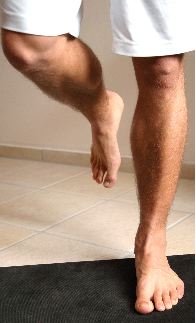It is essential for children, who may find it more difficult to balance when they are going through growth spurts, and in older age, when otherwise balance gets progressively worse, with an increased risk of falls. The exercise is protective for normal activities like walking, as well as sports, especially those with a high risk of ankle sprains, such as basketball, netball and gymnastics.
Position:Stand up straight, preferably barefoot. Always stand near to a support if your balance is poor.
Action: Shift your weight slightly to one side, and lift the other leg off the floor a little way. Hold your balance for as long as you comfortably can, then relax.
Repetitions and frequency: A few times, whenever you can, including when you stand during normal daily activities
Note: Use the support to steady yourself if necessary, but try not to lean on it. Breathe evenly throughout the exercise, do not hold your breath. Keep your head up, back straight, arms relaxed. Try to keep your hips level. If it is easier to balance on one leg than the other, do more repetitions for the more difficult side.
After injury:This is an essential exercise after ankle sprains and foot injuries, but is also essential after any leg injury, including bone fractures and knee and hip problems. After hip or knee operations, being able to hold your balance standing on the operated leg is a prerequisite for walking properly again. The balance exercise should be done as soon as you can take your weight on the injured leg without pain. In chronic ankle weakness which causes repeated sprains, this exercise is vital for reviving the proprioceptive nerve function in the joint.

Action: Shift your weight slightly to one side, and lift the other leg off the floor a little way. Hold your balance for as long as you comfortably can, then relax.
Repetitions and frequency: A few times, whenever you can, including when you stand during normal daily activities
Note: Use the support to steady yourself if necessary, but try not to lean on it. Breathe evenly throughout the exercise, do not hold your breath. Keep your head up, back straight, arms relaxed. Try to keep your hips level. If it is easier to balance on one leg than the other, do more repetitions for the more difficult side.
After injury:This is an essential exercise after ankle sprains and foot injuries, but is also essential after any leg injury, including bone fractures and knee and hip problems. After hip or knee operations, being able to hold your balance standing on the operated leg is a prerequisite for walking properly again. The balance exercise should be done as soon as you can take your weight on the injured leg without pain. In chronic ankle weakness which causes repeated sprains, this exercise is vital for reviving the proprioceptive nerve function in the joint.


